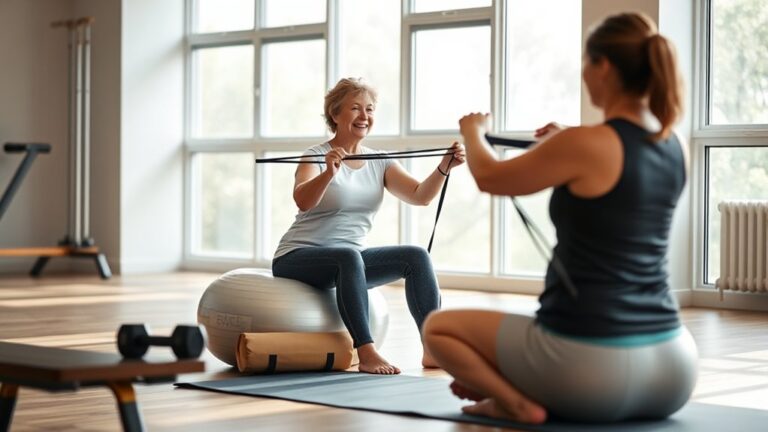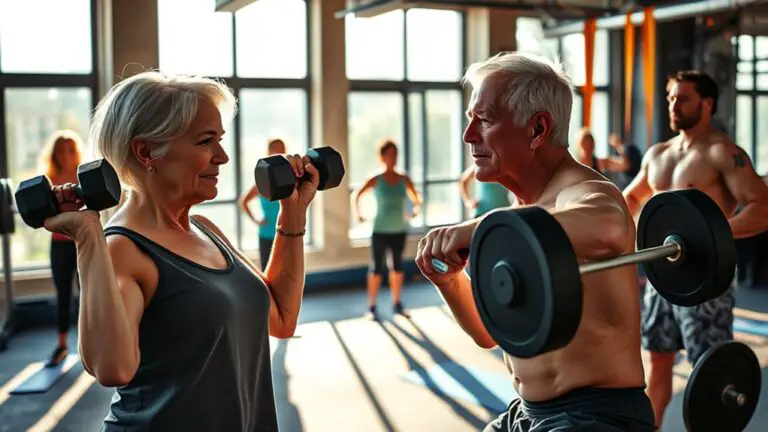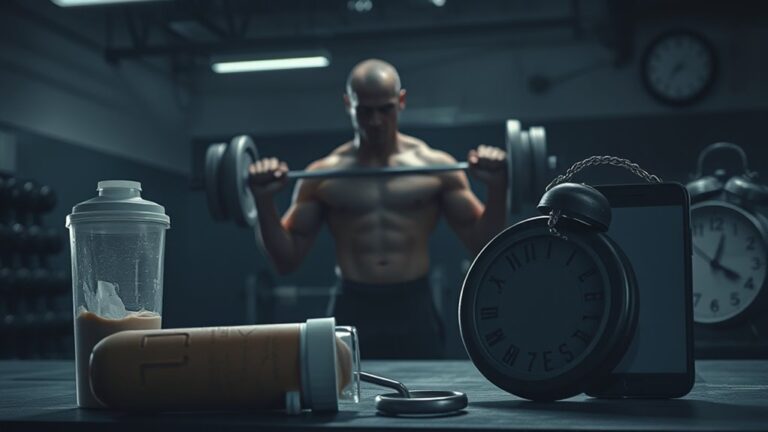The Best Gym Workouts for Cyclists

The best gym workouts for cyclists include strength training, core exercises, and flexibility drills. Focus on lower body workouts like squats and deadlifts to build power and endurance. Add core workouts, such as planks and stability ball exercises, to enhance stability on the bike. Don’t forget upper body strength with pull-ups and dumbbell rows for better control. Incorporating mobility drills like dynamic stretching will keep your muscles supple. Keep exploring for more tips and techniques to elevate your cycling performance!
The Importance of Strength Training for Cyclists
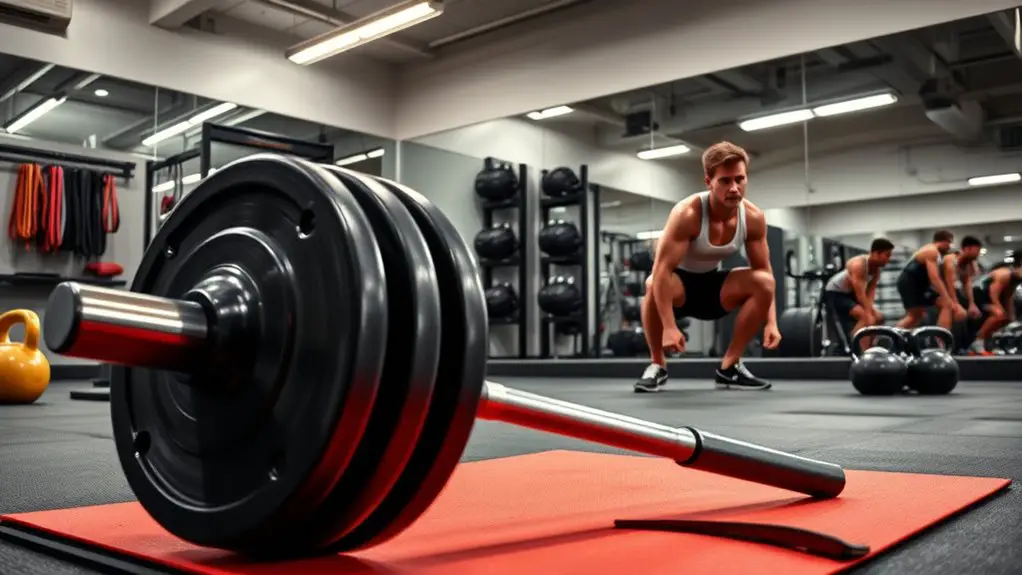
While many cyclists focus solely on endurance, incorporating strength training into your routine can considerably enhance your performance on the bike. Strength training not only builds muscle but also plays an essential role in muscle recovery and injury prevention. By developing stronger muscles, you support your joints and improve your overall stability, which helps reduce the risk of common cycling injuries.
When you engage in targeted strength workouts, you’re not just pushing pedals; you’re fortifying your body to handle the demands of long rides and challenging terrains. This approach allows you to ride longer and with greater efficiency. Additionally, incorporating exercises like skipping rope can provide a powerful cardio workout that complements your strength training and boosts your weight loss efforts.
Additionally, remember to prioritize proper form and technique during your workouts, as this aids in injury prevention. Balancing endurance and strength will guarantee your body stays resilient, making each ride safer and more enjoyable. So, don’t skip the weights—your cycling performance will thank you!
Core Exercises to Enhance Stability
To ride effectively, you need a strong core that stabilizes your body and improves your overall cycling performance. Core exercises enhance your balance, making it easier to maintain control on the bike. Incorporate plank variations into your routine, like side planks and plank jacks, to target different muscle groups while building endurance. These exercises engage your abdominals, obliques, and lower back, essential for cycling stability.
Using a stability ball can further challenge your core. Try ball passes or stability ball rollouts to work on your coordination and strength. These movements not only improve muscle engagement but also help in preventing injuries by promoting better posture and alignment. Adding exercises like Barbell Rollout can also significantly enhance your core strength and stability.
Remember to focus on form over quantity; quality reps will yield better results. By strengthening your core, you’ll ride with more confidence, ensuring a safer and more effective cycling experience.
Lower Body Workouts for Power and Endurance
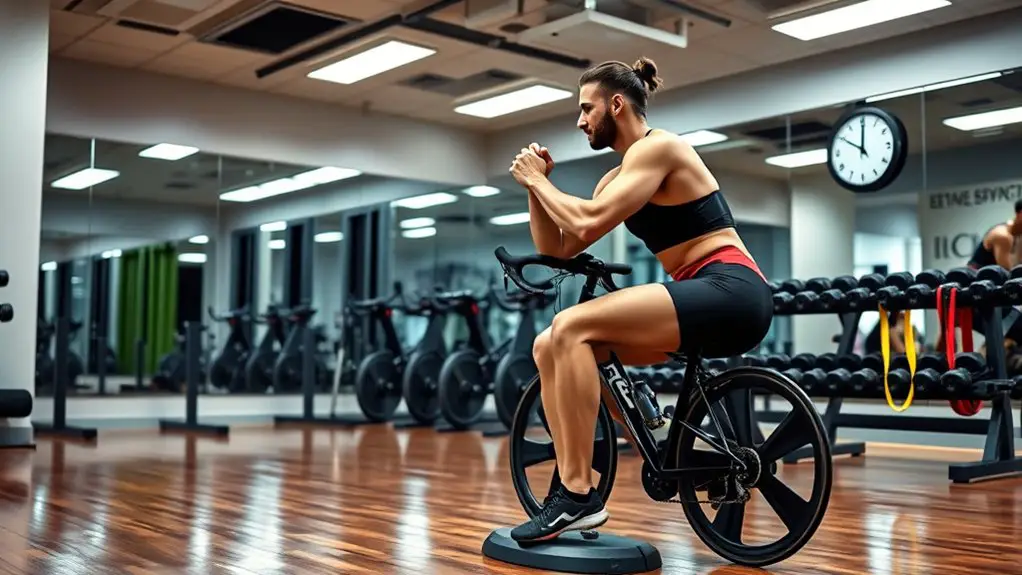
A strong core lays the groundwork for powerful cycling, but the legs are where the real strength comes into play. To build endurance and power, focus on safe and effective lower body workouts. Squat variations, like goblet squats or split squats, help develop muscle strength while keeping your form in check. Always verify your knees track over your toes to avoid injury.
Incorporating deadlift techniques, such as the conventional or Romanian deadlift, can enhance your posterior chain strength, essential for cycling power. Remember to keep your back straight and engage your core throughout the lift. Start with lighter weights to master your form, gradually increasing as you gain confidence. Skipping rope can also enhance coordination and balance, which are crucial for maintaining stability while cycling.
Always warm up before workouts and cool down afterward to prevent injury. By prioritizing safety and effective techniques, you’ll maximize your cycling performance and enjoy a stronger ride on the road.
Upper Body Strength for Improved Control
Building upper body strength is essential for cyclists, as it enhances bike control and stability during rides. Strong shoulders and arms help you maintain better posture and manage your bike more effectively, especially on rough terrain. Focusing on shoulder stability and grip strength is vital for safety and performance. Here are a few exercises to incorporate into your routine:
Building upper body strength is crucial for cyclists to improve bike control, stability, and overall performance on challenging terrain.
- Pull-ups: These boost shoulder stability and overall upper body strength.
- Dumbbell rows: This helps improve your grip strength and contributes to a strong back.
- Plank variations: These enhance core stability, connecting your upper body with your lower body for better control. Additionally, proper technique can minimize any potential strain on your joints during strength training.
Flexibility and Mobility Drills for Better Performance
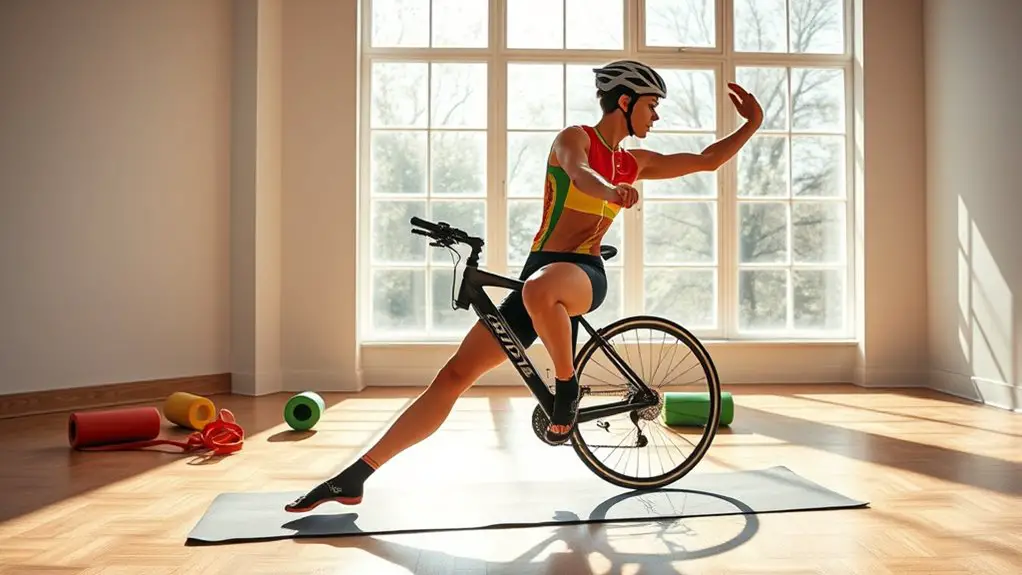
While many cyclists focus on strength training, incorporating flexibility and mobility drills is equally important for enhancing performance. These practices can help you maintain a full range of motion, reduce injury risk, and improve your overall cycling efficiency.
Start your routine with dynamic stretching, which prepares your muscles for the demands of cycling. Movements like leg swings, arm circles, and walking lunges activate your muscles and increase blood flow.
After your workout, don’t forget to use foam rolling. This technique helps alleviate muscle tightness and improve recovery by breaking down knots and increasing blood circulation. Spend a few minutes rolling out your quads, hamstrings, and calves to keep your muscles supple and ready for your next ride.
Plyometric Exercises for Explosive Power
To boost your cycling performance, incorporating plyometric exercises is a great way to develop explosive power. These exercises focus on jump training, enhancing your explosive strength and overall cycling efficiency. When performing plyometrics, it’s essential to prioritize safety to prevent injury. Here are three effective exercises to get you started:
Incorporate plyometric exercises to enhance explosive power and boost your cycling performance efficiently. Prioritize safety to prevent injuries.
- Box Jumps: Jump onto a sturdy platform, landing softly to absorb the impact.
- Broad Jumps: Leap forward as far as you can, focusing on using your legs for maximum distance.
- Jump Squats: Start in a squat position, then explode upward, landing back into the squat.
Always warm up before starting and maintain proper form throughout your workouts. By integrating these plyometric exercises into your routine, you’ll notice improvements in your power output and acceleration on the bike. Stay consistent, and you’ll reap the benefits of explosive strength!
Creating a Balanced Gym Routine for Cyclists
Incorporating plyometric exercises into your fitness regimen can greatly enhance your cycling performance, but a well-rounded gym routine is essential for overall strength and endurance. Balancing strength training, flexibility work, and recovery techniques will maximize cross training benefits, ensuring you’re safe and effective in your workouts.
Here’s a simple structure to follow:
| Day | Focus Area |
|---|---|
| Monday | Strength Training |
| Tuesday | Plyometrics |
| Wednesday | Flexibility & Core |
| Thursday | Active Recovery |
| Friday | Endurance & Power |
On strength training days, prioritize compound movements like squats and deadlifts. Include plyometric drills on Tuesdays to improve explosive power. Incorporate flexibility and core exercises midweek to enhance stability. Active recovery on Thursdays can involve light cycling or yoga, while Fridays should focus on endurance and power intervals. Balancing these elements will keep you safe and improve your cycling performance.
Frequently Asked Questions
How Often Should Cyclists Incorporate Gym Workouts Into Their Routine?
When it comes to incorporating gym workouts into your routine, frequency recommendations suggest aiming for two to three sessions per week. This allows you to balance strength training with your cycling schedule effectively. Consider scheduling workouts on lighter cycling days to avoid fatigue and reduce injury risk. Always listen to your body, and if you’re feeling sore, it’s okay to adjust your routine. Safety should be your top priority while working towards improvement.
What Should I Eat Before a Gym Workout?
Before a gym workout, it’s important to fuel your body with the right pre workout snacks. Aim for a balance of carbohydrates and protein for sustained energy sources. Think about options like a banana with nut butter or a small yogurt with granola. These choices can help prevent fatigue and support your performance. Just remember to eat them about 30 to 60 minutes before your workout for ideal results. Stay safe and energized!
How Long Should Each Gym Session Last?
When considering session duration, aim for about 45 to 60 minutes for most workouts. This timeframe allows you to maintain a good workout intensity without risking fatigue or injury. It’s important to listen to your body; if you feel worn out, don’t hesitate to cut it short. Remember, quality over quantity matters—focused, effective sessions can often yield better results than longer, less intense ones. Stay safe and enjoy your workout!
Can I Do Gym Workouts During Cycling Season?
Absolutely, you can do gym workouts during cycling season! Incorporating strength training can enhance your performance and aid in injury prevention. Just make certain to balance your workouts with adequate rest and recovery. Focus on exercises that target key muscle groups used in cycling, but don’t overdo it. Listening to your body is vital; if you feel fatigued, adjust your routine to guarantee you stay safe and injury-free while enjoying your rides.
What Equipment Is Essential for Cyclists in the Gym?
You might think gym equipment isn’t necessary for cyclists, but it’s vital for building strength and preventing injuries. Essential gear includes resistance bands for targeted muscle work and free weights for overall strength training. These tools allow you to focus on core stability and leg power, which can enhance your cycling performance. Plus, they’re versatile and promote safe, effective workouts by minimizing injury risk while you build endurance and strength.
